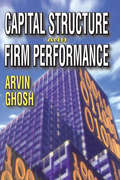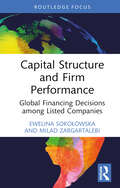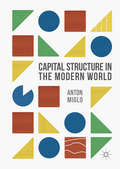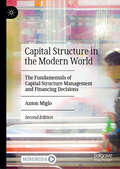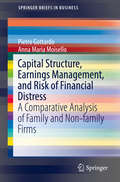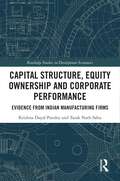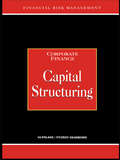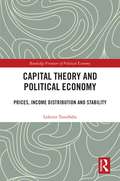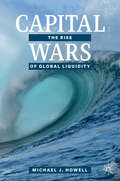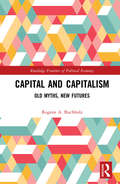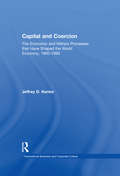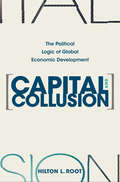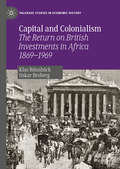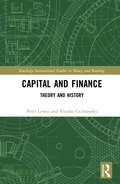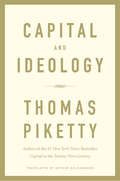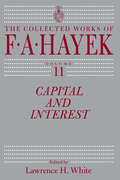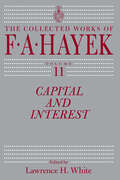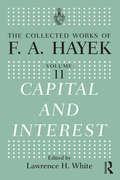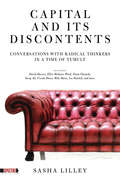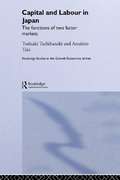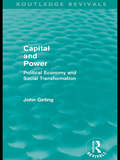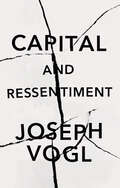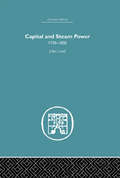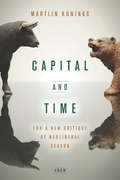- Table View
- List View
Capital Structure and Firm Performance
by Arvin GhoshCapital structure theory is one of the most dynamic areas of finance and forms the basis for modern thinking on the capital structure of firms. Much controversy has resulted from comparisons of the theory of capital structure originally developed by Franco Modigliani and Merton Miller to real-world situations. Two competing theories have emerged over the years, the optimal capital structure theory and the pecking order theory. Arvin Ghosh begins with an overview of the controversies regarding capital structure theories, and then statistically tests both the optimal capital structure and pecking order theories. Using the binomial approach he analyzes the determinants of capital structure while discussing the role of market power in determining capital structure decisions. Ghosh probes the questions of new stock offerings and stockholders' returns, and analyzes capital structure and executive compensation. He then looks into debt financing ownership structure, and the controversal relationship between capital structure and firm profitability. Finally, he discusses the latest developments in the field of capital structure.A concise overview of a major issue in business economics and finance, this volume provides a fuller understanding of capital structure influence on the financial performance of firms, and will certainly stimulate further debate. While hundreds of scholarly articles have been written on the subject this is the first book to test competing theories against measurements of firms' performance and their underlying capital structure.
Capital Structure and Firm Performance: Global Financing Decisions among Listed Companies (Routledge Focus on Economics and Finance)
by Ewelina Sokołowska Milad ZargartalebiIn the complex world of finance, understanding the relationship between a company's capital structure and its overall performance is crucial. This book offers a comprehensive exploration of the interdependence between capital structure decisions and business performance, with a specific focus on German-listed companies. It provides valuable insights into the intricate dynamics of corporate finance.Through a blend of theoretical frameworks, empirical research, and practical applications, the book presents readers with a thorough understanding of how capital structure decisions impact a company's profitability, risk profile, and long-term sustainability. From traditional theories of capital structure to cutting-edge empirical methodologies, the book outlines the latest developments in the field, offering practical tools and strategies for optimising financial decision-making. Moreover, the book explores how different regions and global trends influence capital structure decisions, providing a comprehensive examination of varying practices and the factors that shape them. It delves into specific aspects influencing global capital structures, including an analytical comparison of capital structures across key global markets such as the United States, the European Union, and China. This comparison highlights how economic, cultural, and market dynamics influence corporate leverage decisions. The impact of technological innovations and their role in reshaping financial strategies are also discussed.Designed for scholars, researchers, and advanced students in finance and economics, this book serves as a definitive reference for understanding the complex dynamics of corporate finance. With its rigorous analysis and practical insights, it equips readers with the knowledge and analytical tools needed to navigate the challenges of capital structure decision-making in today's dynamic business environment.
Capital Structure in the Modern World
by Anton MigloThis book focuses on microeconomic foundations of capital structure theory. It combines theoretical results with a large number of examples, exercises and applications. The book examines fundamental ideas in capital structure management, some of which are still not very well understood in the business community, such as Modigliani and Miller s irrelevance result, trade-off theory, pecking-order theory, asset substitution, credit rationing and debt overhang. Chapters also cover capital structure issues that have become very important following the recent financial crisis. Miglo discusses the ways in which financial economists were forced to look critically at capital structure, as the problems faced by many companies stemmed from their financing policies following the crisis. The book also discusses links between capital structure and firm s performance, corporate governance, firm s strategy and flexibility, and covers such topics as life cycle approach to capital structure management, capital structure of small and start-up companies, corporate financing versus project financing and examples of optimal capital structure analyses for different companies. This comprehensive guide to capital structure theory will be of interest to all students, academics and practitioners seeking to understand this fast-developing and critical area of business management. "
Capital Structure in the Modern World: The Fundamentals of Capital Structure Management and Financing Decisions
by Anton MigloThis book focuses on microeconomic foundations of capital structure theory. It combines theoretical results with a large number of examples, exercises and applications. The book examines fundamental ideas in capital structure management, some of which are still not very well understood in the business community, such as Modigliani and Miller&’s irrelevance result, trade-off theory, pecking-order theory, asset substitution, credit rationing and debt overhang. The second edition also covers capital structure issues related to recent developments in financial technology including crowdfunding and token issues and discusses significant differences between these innovative ways of firm financing compared to traditional debt and equity. Chapters also discuss the ways in which financial economists were forced to look critically at capital structure after the financial crisis of 2007-2009 and the COVID-19 pandemic, as the problems faced by many companies stemmed from their financing policies. Further the book analyzes links between capital structure and firm&’s performance, corporate governance, firm&’s strategy and flexibility, and covers such topics as life cycle approach to capital structure management, capital structure of small and start-up companies, corporate financing versus project financing and examples of optimal capital structure analyses for different companies. This comprehensive guide to capital structure theory will be of interest to all students, academics and practitioners seeking to understand this fast-developing and critical area.
Capital Structure, Earnings Management, and Risk of Financial Distress: A Comparative Analysis of Family and Non-family Firms (SpringerBriefs in Business)
by Pietro Gottardo Anna Maria MoiselloThis book analyzes the impacts that family control of firms has on capital structure choices, leverage and the risk of financial distress, earnings management practices, and the relation between accounting choices and firm market value. For these purposes, longitudinal data on Italian family and non-family non-financial firms are closely analyzed. The Italian setting is of special interest in this context because family businesses account for 94% of GDP, families are particularly committed to maintaining control of firms, and the economy is bank based rather than market based. The analyses draw on the socioemotional wealth approach, which emphasizes the importance of the stock of emotional value in family firms, in combination with financial theories such as Pecking Order Theory, Trade-off Theory, and Agency Theory. The findings cast significant new light on differences between family and non-family firms and the effects of different forms of family influence. The book will have broad appeal for academics, managers, practitioners, and policymakers.
Capital Structure, Equity Ownership and Corporate Performance: Evidence from Indian Manufacturing Firms (Routledge Studies in Development Economics)
by Tarak Nath Sahu Krishna Dayal PandeyThis book provides empirical insights into the relationship between capital and equity-ownership structure of Indian manufacturing companies and their financial performance. It discusses and analyses the basic theories and concepts associated with capital structure, debt financing, levered and unlevered firms, the various forms of ownership, agency problem and its kind and the exploitation of minority owners by the large and largest owners. The study employs a set of the most reliable and suitable econometric estimation techniques to draw meaningful inferences on the Indian manufacturing sector. The novelty of this book lies in three particular aspects: the depth and dimension with which the topic is addressed; the robust empirical evidence that it has produced and the simple and intelligible approach with which it is authored. It communicates the crucial relevance of corporate capital structure and equity-ownership to the moderation of agency relationship and shaping the internal governance mechanism, which ultimately results in increased or decreased operational efficiency and financial performance. It will enable readers to understand whether an increased amount of debt capital would bring about positive results for firms or create an extra burden on the management of their finances, preventing them from taking productive investment decisions due to the threat of liquidation. The book will find an audience among advanced students, scholars and researchers who are interested in understanding the corporate finance practices and governance mechanism of Indian organizations.
Capital Structuring: Corporate Finance (Financial Risk Management)
by Brian CoyleFirst Published in 2000. Routledge is an imprint of Taylor & Francis, an informa company.
Capital Theory and Political Economy: Prices, Income Distribution and Stability (Routledge Frontiers of Political Economy)
by Lefteris TsoulfidisIn recent years, there have been a number of new developments in what came to be known as the "Capital Theory Debates". The debates took place mainly during the 1960s as a result of Piero Sraffa's critique of the neoclassical theory according to which the prices of factors of production directly depend on their relative scarcities. Sraffa showed that when income distribution changes, there are many complexities developed within the economic system impacting on prices in ways which are not possible to predict. These debates were revisited in the 1980s and again more recently, along with a parallel literature that has developed among neoclassical economists and has also looked at the impact of shocks on an economy. This book summarizes the debates and issues around the theory of capital and brings to the fore the more recent developments. It also pinpoints the similarities and differences between the various approaches and critically evaluates them in light of available empirical evidence. The focus of the book is on the price trajectories induced by changes in income distribution and the resulting shape of the wage rates of profit curves and frontier. These issues are central to areas such as microeconomics, international trade, growth, technological change and macro stability analysis. Each chapter starts with the theoretical issues involved, followed by their formalization and subsequently with their operationalization. More specifically, the variables of the classical theory of value and distribution are rigorously defined and quantified using actual input–output data from a number of major economies, but mainly from the USA, over long stretches of time. The empirical results are not only consistent with the anticipations of the theory but also further inform and therefore strengthen its predictive content raising new significant questions.
Capital Wars: The Rise of Global Liquidity
by Michael J. HowellEconomic cycles are driven by financial flows, namely quantities of savings and credits, and not by high street inflation or interest rates. Their sweeping destructive powers are expressed through Global Liquidity, a $130 trillion pool of footloose cash. Global Liquidity describes the gross flows of credit and international capital feeding through the world’s banking systems and wholesale money markets. The huge jump in the volume of international financial markets since the mid-1980s has been boosted by deregulation, innovation and easy money, with financial globalisation now surpassing the peaks of integration reached before the First World War. Global Liquidity drives these markets: it is often determinant, frequently disruptive and always fast-moving. Barely one fifth of Wall Street’s huge gains over recent decades have come from earnings: rising liquidity and investors’ appetite for riskier financial assets have propelled stock prices higher. Similar experiences are shared worldwide and even in emerging markets, such as India, flat earnings have not deterred waves of foreign money and domestic mutual funds from driving-up stock prices. Now with central banks actively pursuing quantitative easing policies, industrial corporations flush with cash and rising wealth levels among emerging market investors, the liquidity theory of investment has never been more important.International spill-overs of these rapacious cross-border flows sets off capital wars and exposes the unattractive face of liquidity called ‘risk.’ As the world grows bigger, it becomes ever more volatile. From the early 1960s onwards, the world economy and its financial markets have suffered from three broad types of shocks – labour costs, oil and commodities, and global liquidity. Financial markets spin on fragile axes and the absence of liquidity often provides a warning of upcoming troubles. Global Liquidity is a much-discussed, but narrowly-researched and vaguely-defined topic. This book deeply explores the subject by clearly defining and measuring liquidity worldwide and by showing its importance for investors. The roles of central banks, shadow banking, the rise of Repo and growth of wholesale money are discussed. Additionally, covering the latest developments in China’s increasingly dominant financial economy, this book will appeal to practitioners, policy-makers, economists and academics, as well as those with a general interest in how financial markets work.
Capital and Capitalism: Old Myths, New Futures (Routledge Frontiers of Political Economy)
by Rogene A. BuchholzCapitalist societies need to undergo major change to provide for the material needs of all the people who work within the system, not just the 1 percent. They have become dysfunctional and need a different kind of orientation to continue in existence. Instead of creating wealth, which is what they are supposed to accomplish, they have created nothing but debt for the past several decades and are now in serious trouble with regard to finding the wherewithal to keep on functioning as viable societies that can provide job opportunities for their workers and the promise of a better life in the future for their citizens. The coronavirus pandemic has exposed just how many people live paycheck to paycheck and have not been able to accumulate any kind of savings. The 1 percent, meanwhile, have benefited greatly and have vastly increased their wealth over the past several decades. This book does not advocate the need to turn to a form of socialism, however, to give most workers a chance at a decent life for themselves. What is needed is a redefinition of capitalism to make it work for everyone. Capital and Capitalism seeks to uncover various myths about capitalism that hinder our ability to change the system and discuss the task of redefining capitalism by examining where neo-liberalism went wrong and what role restructuring the corporation along stakeholder lines can play in making capitalism more responsive to the entire society. It will be of interest to researchers, academics, and students in the fields of business and society, leadership, and business ethics.
Capital and Capitalism: Old Myths, New Futures (Routledge Frontiers of Political Economy)
by Rogene A. BuchholzCapitalist societies need to undergo major change to provide for the material needs of all the people who work within the system, not just the 1 percent. They have become dysfunctional and need a different kind of orientation to continue in existence. Instead of creating wealth, which is what they are supposed to accomplish, they have created nothing but debt for the past several decades and are now in serious trouble with regard to finding the wherewithal to keep on functioning as viable societies that can provide job opportunities for their workers and the promise of a better life in the future for their citizens. The coronavirus pandemic has exposed just how many people live paycheck to paycheck and have not been able to accumulate any kind of savings. The 1 percent, meanwhile, have benefited greatly and have vastly increased their wealth over the past several decades. This book does not advocate the need to turn to a form of socialism, however, to give most workers a chance at a decent life for themselves. What is needed is a redefinition of capitalism to make it work for everyone. Capital and Capitalism seeks to uncover various myths about capitalism that hinder our ability to change the system and discuss the task of redefining capitalism by examining where neo-liberalism went wrong and what role restructuring the corporation along stakeholder lines can play in making capitalism more responsive to the entire society.It will be of interest to researchers, academics, and students in the fields of business and society, leadership, and business ethics.
Capital and Coercion: The Economic and Military Processes that Have Shaped the World Economy, 1800-1990 (Transnational Business and Corporate Culture)
by Jeffrey D. KentorFirst Published in 2000. Routledge is an imprint of Taylor & Francis, an informa company.
Capital and Collusion: The Political Logic of Global Economic Development
by Hilton L. RootWhy does capital formation often fail to occur in developing countries? Capital and Collusion explores the political incentives that either foster growth or steal nations' growth prospects. Hilton Root examines the frontier between risk and uncertainty, analyzing the forces driving development in both developed and undeveloped regions. In the former, he argues, institutions reduce everyday economic risks to levels low enough to make people receptive to opportunities for profit, stimulating developments in technology and science. Not so in developing countries. There, institutions that specialize in sharing risk are scarce. Money hides under mattresses and in teapots, creating a gap between a poor nation's savings and its investment. As a consequence, the developing world faces a growing disconnect between the value of its resources and the availability of finance. What are the remedies for eliminating this disparity? Root shows us how to close the growing wealth gap among nations by building institutions that convert uncertainty into risk. Comparing China to India, Latin America to East Asia, and contemporary to historical cases, he offers lessons that can help the World Bank and the International Monetary Fund to tackle the political incentives that are the source of poor governance in developing nations.
Capital and Colonialism: The Return on British Investments in Africa 1869–1969 (Palgrave Studies in Economic History)
by Klas Rönnbäck Oskar BrobergThis book engages in the long-standing debate on the relationship between capitalism and colonialism. Specifically, Rönnbäck and Broberg study the interaction between imperialist policies, colonial institutions and financial markets. Their primary method of analysis is examining micro- and macro-level data relating to a large sample of ventures operating in Africa and traded on the London Stock Exchange between 1869 and 1969. Their study shows that the relationship between capital and colonialism was highly complex. While return from investing in African colonies on average was not extraordinary, there were certainly many occasions when investors enjoyed high return due to various forms of exploitation. While there were actors with rational calculations and deliberate strategies, there was also an important element of chance in determining the return on investment – not least in the mining sector, which overall was the most important business for investment in African ventures during this period. This book finally also demonstrates that the different paths of decolonization in Africa had very diverse effects for investors.
Capital and Finance: Theory and History (Routledge International Studies in Money and Banking)
by Peter Lewin Nicolás CachanoskyThis book applies finance to the field of capital theory. While financial economics is a well-established field of study, the specific application of finance to capital theory remains unexplored. It is the first book to comprehensively study this financial application, which also includes modern financial tools such as Economic Value Added (EVA®). A financial application to the problem of the average period of production includes two discussions that unfold naturally from this application. The first one relates to the dual meaning of capital, one as a monetary fund and the other one as physical (capital) goods. The second concerns its implications for business-cycle theories. This second topic (1) provides a solid financial microeconomic foundation for business cycles and, also (2) makes it easy to compare different business-cycle theories across the average period of production dimension. By clarifying the obscure concept of average period of production, the authors make it easier to analyze the similarities with and differences from other business-cycle theories. By connecting finance with capital theory, they provide a new point of view and analysis of the long-standing problems in capital theory as well as other related topics such as the use of neoclassical production functions and theorizing about business cycles. Finally, they emphasize that the relevance of their application rests on both its policy implications and its contributions to contemporary economic theory.
Capital and Ideology
by Thomas PikettyThomas Piketty’s Capital in the Twenty-First Century showed that capitalism, left to itself, generates deepening inequality. In this audacious follow-up, he challenges us to revolutionize how we think about ideology and history, exposing the ideas that have sustained inequality since premodern times and outlining a fairer economic system. <P><P><b>A New York Times Bestseller</b>
Capital and Interest
by Friedrich A. Hayek Lawrence H. WhiteProduced throughout the first fifteen years of Hayek's career, the writings collected in Capital and Interest see Hayek elaborate upon and extend his landmark lectures that were published as Prices and Production and work toward the technically sophisticated line of thought seen in his later Pure Theory of Capital. Illuminating the development of Hayek's detailed contributions to capital and interest theory, the collection also sheds light on how Hayek's work related to other influential economists of the time. Highlights include the 1936 article "The Mythology of Capital"--presented here alongside Frank Knight's criticisms of the Austrian theory of capital that prompted it--and "The Maintenance of Capital," with subsequent comments by the English economist A. C. Pigou. These and other familiar works are accompanied by lesser-known articles and lectures, including a lecture on technological progress and excess capacity. An introduction by the book's editor, leading Hayek scholar Lawrence H. White, places Hayek's contributions in careful historical context, with ample footnotes and citations for further reading, making this a touchstone addition to the University of Chicago Press's Collected Works of F. A. Hayek series.
Capital and Interest (The Collected Works of F. A. Hayek)
by F. A. HayekProduced throughout the first fifteen years of Hayek’s career, the writings collected in Capital and Interest see Hayek elaborate upon and extend his landmark lectures that were published as Prices and Production and work toward the technically sophisticated line of thought seen in his later Pure Theory of Capital. Illuminating the development of Hayek’s detailed contributions to capital and interest theory, the collection also sheds light on how Hayek’s work related to other influential economists of the time. Highlights include the 1936 article “The Mythology of Capital”—presented here alongside Frank Knight’s criticisms of the Austrian theory of capital that prompted it—and “The Maintenance of Capital,” with subsequent comments by the English economist A. C. Pigou. These and other familiar works are accompanied by lesser-known articles and lectures, including a lecture on technological progress and excess capacity. An introduction by the book’s editor, leading Hayek scholar Lawrence H. White, places Hayek’s contributions in careful historical context, with ample footnotes and citations for further reading, making this a touchstone addition to the University of Chicago Press’s Collected Works of F. A. Hayek series.
Capital and Interest (The Collected Works of F.A. Hayek #11)
by Lawrence H. WhiteProduced throughout the first fifteen years of Hayek's career, the writings collected in Capital and Interest see Hayek elaborate upon and extend his landmark lectures that were published as Prices and Production and work toward the technically sophisticated line of thought seen in his later Pure Theory of Capital. Illuminating the development of Hayek's detailed contributions to capital and interest theory, the collection also sheds light on how Hayek's work related to other influential economists of the time. <P><P>Highlights include the 1936 article 'The Mythology of Capital' presented here alongside Frank Knight's criticisms of the Austrian theory of capital that prompted it - and 'The Maintenance of Capital', with subsequent comments by the English economist A. C. Pigou. These and other familiar works are accompanied by lesser-known articles and lectures, including a lecture on technological progress and excess capacity. An introduction by the book's editor, leading Hayek scholar Lawrence H. White, places Hayek's contributions in careful historical context, with ample footnotes and citations for further reading, making this a touchstone addition to the University of Chicago Press's Collected Works of F. A. Hayek series.
Capital and Its Discontents: Conversations with Radical Thinkers in a Time of Tumult (Spectre)
by Sasha LilleyUnraveling the complicated details surrounding the world's present economic and political climate, this collection of interviews addresses the faulty underpinnings of capitalism and discusses why the future must be economically founded otherwise. Probing into the roots of the global economic crisis, the role that debt and privatization play in dampening social revolt, and the ramifications of post-colonial mentality in the Global South, this collection provides the tools for reconsidering capitalism and solutions for surviving current crisis by learning from past mistakes. This collection includes conversations with some of the most noted thinkers and political economists on the Left, including Noam Chomsky, Tariq Ali, Mike Davis, David Harvey, Ellen Meiksins Wood, and Doug Henwood.
Capital and Labour in Japan: The Functions of Two Factor Markets (Routledge Studies in the Growth Economies of Asia #Vol. 26)
by Toshiaki Tachibanaki Atsuhiro TakiToshiaki Tachibanaki and Atsuhiro Taki emphasise several institutional features in Japan which differ from those in Euro-American countries: for example, the permanent employment and seniority system in wages and promotion, the dual structure, Keiretsu transactions, the main bank system, and intercorporate shareholding. This book examines in particular the distinction between long-run and short-run contractual relationships which produced such features. It presents both the positive and the negative evaluations of the factor market. Exploring the similarities and interdependencies between two important and idiosyncratic factor markets in Japan, this book brings data to hand which until now has only been available in specialist journals.
Capital and Power: Political Economy and Social Transformation (Routledge Revivals)
by John GirlingFirst published in 1987, this book comprises a critical evaluation of Marxist, Gramscian and pluralist theories of social development; the application of these theories, chiefly to Third World countries: hence consideration of the problems of ‘specificity’, general theory and social change. This is followed by an assessment of the stages of economic development in relation to state power and politics; and the role of the ‘external’: the impact of the world market economy and the security imperative. The book is not a discussion of theory, but of theory-in-practice. Above all, it represents a continuing debate between Marxism and pluralism – on the themes of accumulation, power, legitimacy – resulting in convergence.
Capital and Ressentiment: A Short Theory of the Present
by Joseph VoglThe proliferation of social media has provided ideal conditions in which feelings of anger and frustration can be expressed and shared, forming a deep pool of ressentiment that is being drawn upon and exploited by populist and authoritarian leaders.In his new book, Joseph Vogl shows how this dynamic is rooted in the fusing of finance capital and information in a new form of information capitalism that is reshaping the affective economy of our societies. The capital accumulation strategies of powerful new platforms and social media are pushing people into fragmented, opposing, and conflictual communities where ressentiment is nurtured and grows. The feelings of grievance and rejection generated by capitalism are redirected into attacks on migrants, foreigners, and others, thereby deflecting their critical potential, and bolstering the system that is their source. It is the cunning of ressentiment that provides the key to understanding why, despite the profusion of communication in our social media age, global finance and information capital can be neither understood nor attacked as a totalizing power.This brilliant analysis of the ways in which information capitalism is transforming the affective economy of our societies will be of great interest to anyone concerned with the forces that are shaping our societies today.
Capital and Steam Power: 1750-1800
by John LordWhen it appeared in 1923, John Lord’s Capital and Steam Power 1750–1800 was the first book to be based on the voluminous Boultori and Watt papers in Birmingham since the hey-day of Samuel Smiles. Although Lord’s conclusions have been modified and corrected on various points, this book still remains the best short account of the significance of this classic engineering partnership which bulks so large in the history of technology and of the Industrial Revolution in Britain. "Mr. Lord’s Capital and Steam Power 1750–1800 is an important contribution to economic history … His introductory sketch of economic conditions from 1700 to 1750 and his concluding summary of the main results of the developments which he has described, without having the same novelty as his central theme, are scholarly and intelligent." R. H. Tawney, Economica, February, 1924 "His study of the application of steam to industry is a useful piece of research." T. S. Ashton, The Economic Journal, December, 1924
Capital and Time: For a New Critique of Neoliberal Reason
by Martijn KoningsCritics of capitalist finance tend to focus on its speculative character. Our financial markets, they lament, encourage irresponsible bets on the future that reflect no real underlying value. Why is it, then, that opportunities for speculative investment continue to proliferate in the wake of major economic crises? To make sense of this, Capital and Time advances an understanding of economy as a process whereby patterns of order emerge out of the interaction of speculative investments. Progressive critics have assumed that the state occupies a neutral, external position from which it can step in to constrain speculative behaviors. On the contrary, Martijn Konings argues, the state has always been deeply implicated in the speculative dynamics of economic life. Through these insights, he offers a new interpretation of both the economic problems that emerged during the 1970s and the way that neoliberalism responded to them. Neoliberalism's strength derives from its intuition that there is no position that transcends the secular logic of risk, and from its insistence that individuals actively engage that logic. Not only is the critique of speculation misleading as a general approach; it is also incapable of recognizing how American capitalism has come to embrace speculation and has thus been able to generate new kinds of order and governance.
